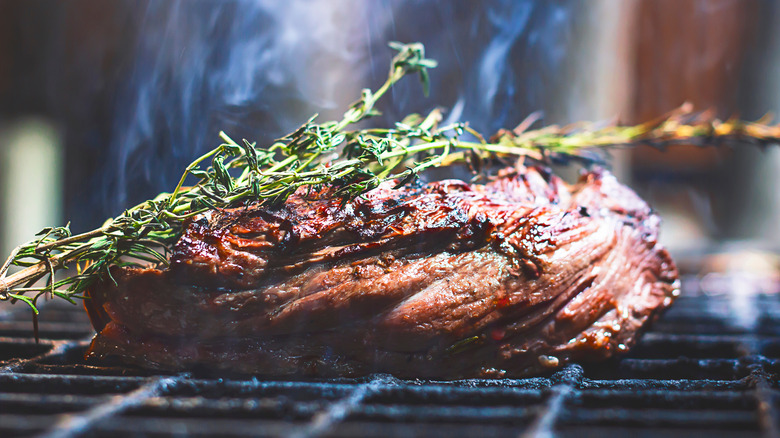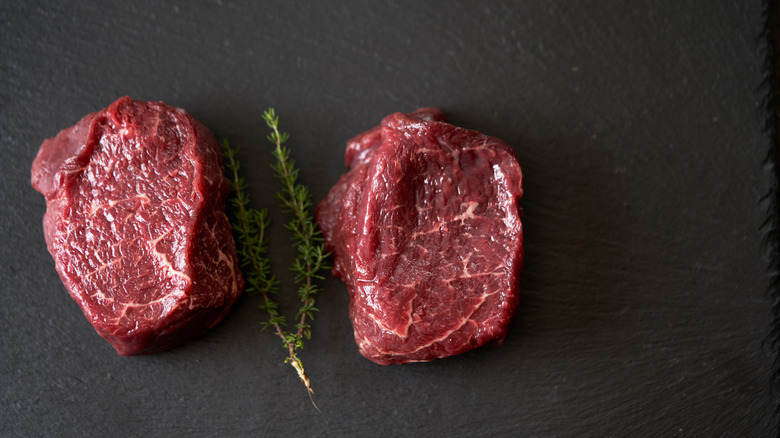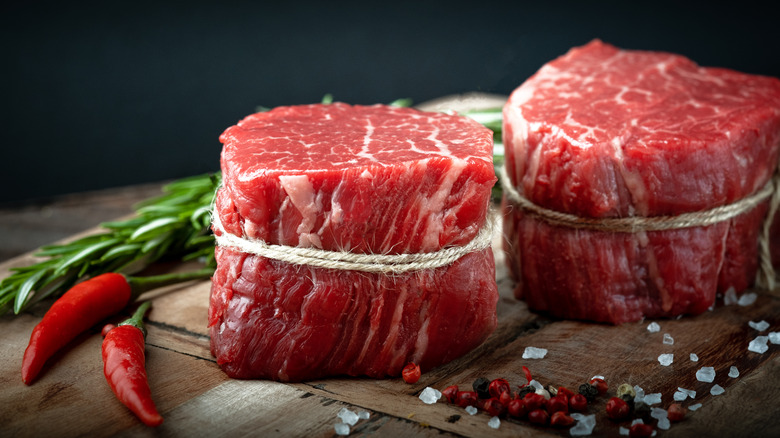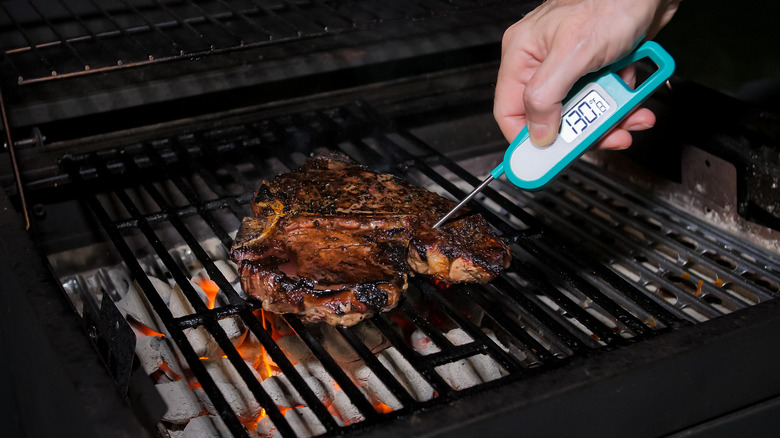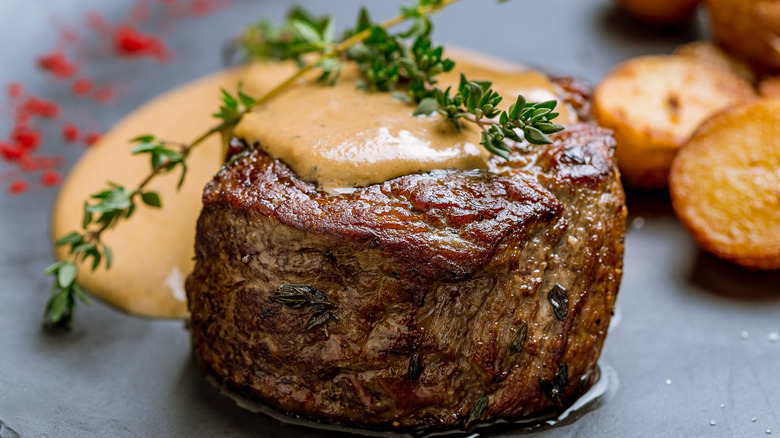Grillmaster Reveals The Most Common Mistakes You're Making While Grilling Steak Filets
While the calendar (and, in some of the more northern states, the weather) may say different, Memorial Day marks the unofficial start of summer, and also ushers in the grilling season. Grilling, as a cooking technique, seems to divide people into two camps: There are some cooks who will fearlessly take on any kitchen cooking challenge but are reluctant to tackle the task of preparing food outside over an open flame, while others, who can barely tell one stove burner from another, are in their element presiding over a backyard barbecue.
And no, despite some lingering decades-old stereotypes featuring some archetypal mid-century suburban dad "manning" the grill, these camps don't separate out along gender lines. In fact, the barbecue expert Mashed turned to for steak-grilling tips is a woman: Melissa Cookston, seven-time world barbecue champion, cookbook author, and owner of restaurant chain Memphis BBQ Company. She also served as a judge on Season 1 of the Netflix series "American BBQ."
Cookston offered some tips that will help both the barbecue newbie and the experienced pro alike to grill up a steak that's tender and juicy as opposed to one that's tougher than Chuck Norris' old boot. While some chefs may feel that the filet mignon is a cut better suited to a pan than a grill, Cookston says that ain't necessarily so — at least, not if you know the tricks of the trade.
It's important to choose the right-size steaks
When it comes to selecting a steak to grill, size and shape really do matter. Cookston tells us that filet mignons are cut from the beef tenderloin, so these can be thinner or thicker depending on what part of the tenderloin they came from. "When selecting your filets always have the end result in mind," she says. If you want your steaks to come out rare or medium-rare, she suggests picking a thick piece of steak. For a steak that's medium-well, she says to pick a thinner steak.
Another technique you can use that will make your steak thinner is to butterfly it. This technique, Cookston tells us, involves "cutting [the steaks] almost in half and folding them out so you have a thinner steak with a larger surface area to grill." This technique may come in handy if you're cooking the steaks to order and you have someone who'd like a more well-done steak when all you have on hand are thicker cuts of meat. With just a little bit of knife work, you'll have a thin filet that can be cooked to well-done in no time at all.
Be sure to tie up the steaks
While it might sound cruel or strange, you really should start tying up your food. Not with ribbons and bows, but with plain butcher's twine. This string is able to withstand high cooking temps without burning, won't melt since it's made of cotton, and also won't impart any off-flavors to your food.
While you might be familiar with it (or at least have seen pics) being used to truss up a pot roast or a roast chicken or turkey, Cookston also says she likes to keep butcher's twine on hand for when she's grilling a steak filet. "I always tie a piece of chef's twine around my filets to keep them nice and round," she tells us, adding, "This will also help keep moisture in the steak." While steak filets can be a very tender cut if cooked properly, they are on the lean side, and Cookston explains that "they don't have as much internal marbling as other steaks to keep them juicy" so every bit of extra moisture helps.
Don't guess the temperature
When you're grilling a ribeye — a steak that Cookston says has plenty of "intrinsic marbling" even if you overcook it a teeny bit — it should still be fairly juicy. With a filet mignon, however, it's a whole different story. As Cookston points out, "Filets don't have the marbling to maintain flavor and moisture if they are overcooked." So how does she make sure she never leaves her filets on the grill for too long, thus making a very expensive "misteak?" Simple — she has a go-to tool that helps with this. "'I've cooked probably hundreds of thousands of steaks over the years," says Cookston. "And yes, I still use a meat thermometer. "
Cookston, barbecue professional that she is, uses one of the fancier types of meat thermometers available, one where you can set the desired temperature and the thermometer will alert you when this temp is reached. You can also, of course, use a plain old low-tech meat thermometer where you just poke it into the meat and read the output yourself. If you use such a thermometer when cooking in the oven, there's going to be some heat loss every time you open the oven door. With food cooked on the grill, however, this is a non-issue so you can take your steak's temperature as often as you like without harming the steak one bit.
Lean on the reverse sear technique
While the reverse sear technique usually refers to cooking your meat in the oven before finishing it off in a frying pan, Cookston says you not only can, but should, use it for steaks prepared on the grill. In order to reverse-sear a grilled steak, you'll need to set up something she calls a "two-zone fire." Bon Appétit says this can easily be achieved on a gas grill by simply turning one side up and the other down, but with a charcoal grill you'll have to arrange the coals so there's a high mound on one side sloping down to a low pile on the other.
For a reverse sear, Cookston says to start the steaks on the cool side and pull them when they hit 110 degrees F. Rest them for five minutes, then return them to the hot side of the grill (Which should be between 450 and 550 degrees F). While Cookston says the steaks can be cooked directly on the grate, she tells us, "My favorite is to put a cast iron pan down for a true sear" and advises using a little high-temperature oil (she recommends avocado) in the pan or on the grates. Cook the steaks for two to three minutes, flip, then cook until the desired temperature is reached. "With this method resting after the cook is not necessary, so it's time to enjoy!" says Cookston. Mmm, a dinner like that wouldn't just "meat" expectations, it would exceed them!
